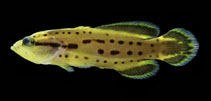| Family: |
Grammistidae (Soapfishes) |
| Max. size: |
18 cm TL (male/unsexed) |
| Environment: |
reef-associated; marine; depth range 1 - 26 m |
| Distribution: |
Western Atlantic: Eastern Atlantic and Brazilian populations need further investigation, (including morphological and genetic), to determine if they represent R. subbifrenatus or undescribed species (Ref. 89885). |
| Diagnosis: |
Dorsal spines (total): 3-4; Dorsal soft rays (total): 21-25; Anal spines: 1-1; Anal soft rays: 11-13. This species is distinguished from its congeners by the following set of characters: pectoral fin and distal portions of soft dorsal, caudal, and anal fins are tan to brown in life and when preserved; numerous dark spots on head and trunk; spots on head posterior to horizontal through center of orbit usually prominent, round or oblong, and one or more usually equal in size to or larger than diameter of pupil; posterior portion of interorbital region usually with 2 pairs of spots (sometimes joined as a stripe), spots directly on or abutting orbital rim; belly and caudal fin usually without spots; D III or IV (nearly bimodal), total dorsal-fin elements modally 26; pectoral fin rays modally 16; total caudal-fin rays modally 25; lower jaw extending anteriorly beyond upper jaw, mean difference between distance from tip of lower jaw to orbit and tip of upper jaw to orbit 4% HL; caudal peduncle relatively wide, average depth 13% SL (Ref. 89885). |
| Biology: |
Inhabits clear tropical waters to depths of 26 m, but it is found most commonly at 1-2 m (mean maximum depth of specimens collected is 5 m, only 6 were captured deeper than 15 m). Lives in tide pools, among coral rubble, in patch reefs and shallow spur and groove reef areas, occasionally found on steep vertical walls (Ref. 89885). A solitary species (Ref. 26340). Adults are said to prefer clearer waters than juveniles (Ref. 7320). |
| IUCN Red List Status: |
Least Concern (LC); Date assessed: 23 August 2012 Ref. (130435)
|
| Threat to humans: |
harmless |
| Country info: |
|
Source and more info: www.fishbase.org. For personal, classroom, and other internal use only. Not for publication.

